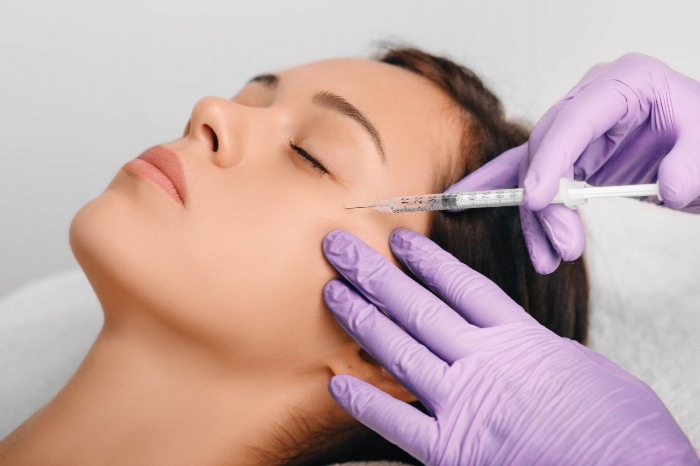Beauty & Cosmetics
Botulinum toxin resistance emerges as key factor for safe use
Patients should use high-quality purified toxin at a correct dosage to prevent risk, experts say
By Apr 21, 2023 (Gmt+09:00)
3
Min read
Most Read
LG Chem to sell water filter business to Glenwood PE for $692 million


KT&G eyes overseas M&A after rejecting activist fund's offer


Kyobo Life poised to buy Japan’s SBI Group-owned savings bank


StockX in merger talks with Naver’s online reseller Kream


Meritz backs half of ex-manager’s $210 mn hedge fund



As demand for botulinum toxin for aesthetic purposes is globally increasing, safe use of the drug has emerged as one of the most important issues in the medical industry.
More consumers and medical professionals should be aware of resistance to and risks of the injections, said Park Je-young, chief director of Apgujeong Oracle Dermatology Clinic, at a medical conference held in Seoul earlier this month. He attended the annual conference, called the Aesthetic Council for Ethical Use of Neurotoxin Delivery (ASCEND), as a panelist from Korea.
The panels discussed global guidelines for the safe and ethical use of botulinum toxin at the conference, hosted by Germany-based Merz Aesthetics. The toxin has been used globally since 1999 to treat wrinkles and square jawlines and help body contouring.
“We will make our best efforts for the safe and efficient use of botulinum toxin," said Samantha Kerr, chief scientific officer (CSO) of Merz Aesthetics.
The council gave a presentation on botulinum neurotoxin’s resistance at the International Society of Aesthetic Plastic Surgery (ISAPS) conference last year, aiming to address resistance issues by using high-purity toxin at the correct dosage.

GROWING DEMAND FOR AESTHETICS
Botulinum toxin is a type of neurotoxin protein, which can inhibit the secretion of neurotransmitters, thus temporarily paralyzing muscles for medical or aesthetic treatment.
The botulinum toxin market in Korea has grown at a compounded annual rate of 10% to 190 billion won ($143 million) last year from 157 billion won in 2020, according to Samsung Securities Co.’s report. It will expand to 209 billion won this year, the brokerage house said. The global market of the toxin is estimated at 8.5 trillion won.
The protein takes 10-20 minutes to administer and is less expensive and fast acting than other aesthetic treatments. About 60% of botulinum toxin users in Korea have had the toxin injections for more than two years, according to the Korean Association for Laser, Dermatology and Trichology.
Korea has 15 licensed botulinum toxin products in the local market. As the toxin makers heat up the market with new products, the government is intensifying its systems to control bioterrorism agents and infectious diseases.

INCREASING RESISTANCE
More medical experts are paying attention to the resistance to the toxin. The protein is made by culturing Clostridia bacteria, which produce the neurotoxin. When the bacteria wrap the neurotoxin to protect it from toxicity, resistance can occur. Such resistance to the toxin can develop from frequent injections or excessive doses.
According to Frost & Sullivan’s survey in 2021, about 80% of 2,441 botulinum toxin users across eight APAC countries said their toxin treatments are less effective after the first injection. The percentage increased by 1,000 basis points from 2018.
To prevent resistance, consumers should use only the correct dosage of the toxin and keep the treatment cycles. For example, injections for wrinkle treatments and high-dose body contouring should be carried out at least three and six months apart, respectively.
Experts recommend that practitioners should use high-purity products that don’t contain complex proteins or inactivated neurotoxins, which can cause resistance. Also, sodium chloride (NaCl), which is used to stabilize the formulation, can also increase the risk of resistance.
High-quality neurotoxin is purified to exclude complex proteins and bacterial deoxyribonucleic acid (DNA) contaminants, said Michael Martin, a world-renowned immunologist.
"Botulinum toxin is effective for neurological conditions such as quadriplegia, cervical dystonia and chronic migraines," he said. “It is important to use purified toxin as the development of resistance can affect the choice of treatment options in the future," he added.
Write to Ji-Hyun Lee at bluesky@hankyung.com
Jihyun Kim edited this article.
More to Read
-
 Bio & PharmaKorean court rules Daewoong poached Medytox’s botox strain
Bio & PharmaKorean court rules Daewoong poached Medytox’s botox strainFeb 10, 2023 (Gmt+09:00)
2 Min read -
 Bio & PharmaHugel accelerates European botox sales with Poland's approval
Bio & PharmaHugel accelerates European botox sales with Poland's approvalJun 03, 2022 (Gmt+09:00)
1 Min read -
 Bio & PharmaMedytox-Hugel dispute over botox strain intensifies with ITC probe
Bio & PharmaMedytox-Hugel dispute over botox strain intensifies with ITC probeMay 03, 2022 (Gmt+09:00)
3 Min read -
 Bio & PharmaMedytox files complaint with ITC against Hugel over botox strain
Bio & PharmaMedytox files complaint with ITC against Hugel over botox strainApr 01, 2022 (Gmt+09:00)
3 Min read -
 Mergers & AcquisitionsGS ups spending to take control of botox maker Hugel
Mergers & AcquisitionsGS ups spending to take control of botox maker HugelFeb 13, 2022 (Gmt+09:00)
1 Min read
Comment 0
LOG IN


